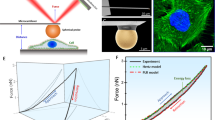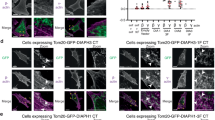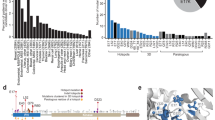Abstract
Heteroploid mouse NIH 3T3 fibroblasts and several rat fibroblast strains (Rat-1, Rat-2 and REF-52) are cell lines of special interest in the field of carcinogenesis because of their extensive use as normal cells in transformation assays for putative cancer-causing genes. Exposure of these cells to carcinogenic chemicals or oncogenic DNA produces anchorage-independent cells with retracted cytoplasms that lack actin cables1–7. All human fibroblast strains, normal and transformed, synthesize two electrophoretic forms of actin (β- and γ-actin)8–10. In contrast, we discovered that early-passage mouse and rat strains synthesize abundant amounts of each of the three electrophoretic forms of actin (α-, β- and γ-actin) but mouse and rat cancer cells express only β- and γ-actins. We now show that in NIH 3T3 and Rat-2 fibroblasts a third actin, the smooth muscle α isoform, is abundantly co-expressed with β-and γ-actin. In every instance tested following transformation to tumorigenicity, the accumulation of a-actin messenger RNA and α-actin synthesis was greatly inhibited. Shutdown of α-actin expression thus appears to be a reproducible transformation-sensitive marker in rodent fibroblasts.
This is a preview of subscription content, access via your institution
Access options
Subscribe to this journal
Receive 51 print issues and online access
$199.00 per year
only $3.90 per issue
Buy this article
- Purchase on SpringerLink
- Instant access to full article PDF
Prices may be subject to local taxes which are calculated during checkout
Similar content being viewed by others
References
Topp, W. C. Virology 113, 408–411 (1981).
Aaronson, S. A. & Todaro, G. J. J. cell. Physiol. 72, 141–148 (1968).
Land, H., Parada, L. F. & Weinberg, R. A. Nature 304, 596–602 (1983).
Tabin, C. J. et al. Nature 300, 143–149 (1982).
Parker, R. C., Varmus, H. E. & Bishop, J. M. Cell 37, 131–139 (1984).
Eva, A., Tronick, S. R., Gol, R. A., Pierce, J. H. & Aaronson, S. A. Proc. natn. Acad. Sci. U.S.A., 80, 4926–4930 (1983).
Pollack, R., Osborn, M. & Weber, K. Proc. natn. Acad. Sci. U.S.A. 72, 994–998 (1975).
Leavitt, J. et al. Cell 28, 259–268 (1982).
Leavitt, J. & Kakunaga, T. J. biol. Chem. 255, 1650–1661 (1980).
Leavitt, J., Leavitt, A. & Attallah, A. J. biol. Chem. 255, 4984–4987 (1980).
Latter, G. I., Burbeck, S., Fleming, J. Leavitt, J. clin. Chem. 30, 1925–1932 (1985).
Jariwalla, R. J., Aurelian, L. & Ts'o, P. O. P. Proc. natn. Acad. Sci. U.S.A. 80, 5902–5906 (1983).
Clanton, D. J., Jariwalla, R. J., Kress, C. & Rosenthal, L. Proc. natn. Acad. Sci. U.S.A. 80, 5107–5111 (1983).
Franza, B. R. & Garrels, J. I. Cancer Cells 1, 137–146 (1984).
Gunning, P., Ponte, P., Kedes, L., Hickey, R. J. & Skoultchi, A. I. Cell 36, 709–715 (1984).
Ponte, P., Gunning, P., Blau, H. & Kedes, L. Molec. cell. Biol. 3, 1783–1791 (1983).
Garrels, J. I. & Gibson, W. Cell 9, 793–805 (1976).
Hunter, T. & Garrels, J. I. Cell 12, 767–781 (1977).
Vandekerckhove, J. & Weber, K. J. molec. Biol. 126, 783–802 (1978).
Vandekerckhove, J. Weber, K. Eur. J. Biochem. 113, 595–603 (1981).
Matsumura, F., Lin, J. J.-C., Yamashiro-Matsumura, S., Thomas, G. P. & Topp, W. C. J. biol. Chem. 258, 13954–13964 (1983).
Leavitt, J., Barren, J. C., Crawford, B. D. & Ts'o, P. O. P. Nature 271, 262–265 (1978).
Naharro, G., Robbins, K. C. & Reddy, E. P. Science 223, 63–66 (1984).
Goldstein, D. & Leavitt, J. Cancer Res. (in the press).
Vanderkerckhove, J., Leavitt, J., Kakunaga, T. Weber, K. Cell 22, 893–899 (1980).
Friedman, E., Verderame, M., Winawer, S. & Pollack, R. Cancer Res. 44, 3040–3050 (1984).
Gunning, P. et al. Molec. cell. Biol. 3, 787–795 (1983).
Gunning, P., Mohun, T., Ng, S-Y. Ponte, P. & Kedes, L. J. molec. Evol. 20, 202–214 (1984).
Rigby, P. W., Dieckmann, M., Rhodes, C. & Berg, P. J. Molec. cell. Biol. 113, 237–251 (1977).
Denhardt, D. T. Biochem. biophys. Res. Commun. 23, 641–646 (1966).
Author information
Authors and Affiliations
Rights and permissions
About this article
Cite this article
Leavitt, J., Gunning, P., Kedes, L. et al. Smooth muscle α-actin is a transformation-sensitive marker for mouse NIH 3T3 and Rat-2 cells. Nature 316, 840–842 (1985). https://doi.org/10.1038/316840a0
Received:
Accepted:
Issue date:
DOI: https://doi.org/10.1038/316840a0
This article is cited by
-
Expression of the actin-associated protein transgelin (SM22) is decreased in prostate cancer
Cell and Tissue Research (2010)
-
Differential gene expression in mouse mammary adenocarcinomas in the presence and absence of wild type p53
Oncogene (2000)
-
Thermotropic phase behavior of in vivo extracted human stratum corneum lipids
Lipids (1997)
-
Alterations in the expression of the ?-cytoplasmic and the ?-smooth muscle actins in hypertrophied urinary bladder smooth muscle
Molecular and Cellular Biochemistry (1994)
-
Actin structural proteins in cell motility
Cancer and Metastasis Review (1992)



